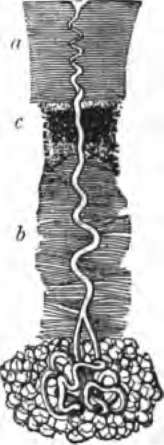The Glands Of The Skin
Description
This section is from the book "The Human Body: An Elementary Text-Book Of Anatomy, Physiology, And Hygiene", by H. Newell Martin. Also available from Amazon: The Human Body.
The Glands Of The Skin
The Glands Of The Skin are of two kinds, the sweat glands or sudoriparous glands, and the oil glands or sebaceous glands.
The Sweat Glands
The Sweat Glands (Fig. 78) are microscopic tubes which reach from the surface of the skin to the subcutaneous areolar tissue ; then the tube often branches, and is coiled up into a little knot, intertwined with blood capillaries. These glands are found all over the skin, but are most abundant on the palms of the hands, the soles of the feet, and the brow. Altogether, there are about two and a half millions of them.
The perspiration or sweat poured out by the sudoriparous glands is a transparent colorless liquid, with a peculiar odor, varying in different races, and in the same individual in different regions of the body. Its quantity in twenty-four hours is subject to great variations, but usually lies between 10,850 and 31,000 grains (or 25 and 71 ounces). The amount is influenced mainly by the surrounding temperature, being greater when this is high ; but it is also increased by other things tending to raise the temperature of the body, as muscular exercise.* The sweat may or may not evaporate as fast as it is secreted ; in the former case it is known as insensible, in the latter as sensible perspiration. By far the most passes off in the insensible form, drops of sweat only accumulating when the secretion is very profuse, or the surrounding atmosphere is so humid that it does not readily take up more moisture. The perspiration in 1000 parts contains 990 of water to 10 of solids. Among the latter is, in health, a little urea, some sodium chloride, and other salts. In diseased conditions of the kidneys the urea may be greatly increased, the skin supplementing to a certain extent deficiencies of those organs.

Fig. 78. A sweat gland, d, horny layer of cuticle; c, Malpighian layer; 6, dermis. The coils of the gland proper, imbedded in the subcutaneous fat, are seen below the dermis.
What is the matrix of a nail ? When does the nail grow longer? What is the bed of a nail? How does a nail grow thicker? Which is its thickest part? What is necessary in order that a "cast nail " maybe reproduced?
What glands are found in the skin ? Describe a sweat gland. Where are the sweat glands most numerous ? How many are there on the whole skin?
Continue to:
